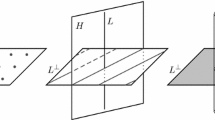Abstract
Conversion of a given integer program into a sequence of smaller subproblems — also integer programs — is demonstrated in this paper. The fundamental procedure is a primal cutting plane method similar to the Simplified Primal Algorithm of Glover [3] and Young [8]. At the subproblem level either cutting plane methods or enumerative methods are feasible. No computational results are available. Hopefully the method will provide, among other things, a vehicle for extending the computational power of enumerative methods to larger problems, since the use of these methods is confined to comparatively small subproblems.
Similar content being viewed by others
References
L.R. Arnold and M. Bellmore, “Iteration skipping in primal integer programming”,Operations Research 22 (1974) 129–136.
A. Ben-Israel and A. Charnes, “On some problems of diophantine programming”,Cahiers (1962) 215–280.
F. Glover, “A new foundation for a simplified primal integer programming algorithm”,Operations Research 16 (1968) 727–740.
Ralph E. Gomory, “An all-integer programming algorithm”, in: J.F. Muth and Gerald L. Thompson, eds.Industrial Scheduling (Prentice-Hall, Englewood Cliffs, N.J., 1963) pp. 193–206.
R.H. Gonzalez-Zubieta, “On some aspects of integer linear programming”, Tech. Rept. No. 16, Operations Research Center, MIT (June 1965).
S.J. Mathis, Jr., “A counterexample to the rudimentary primal integer programming algorithm”,Operations Research 19 (1971) 1518–1522.
R.D. Young, “A primal (all-integer) integer programming algorithm”,Journal of Research of the National Bureau of Standards 69B (3) (1965).
R.D. Young, “A simplified primal (all-integer) algorithm”,Operations Research 16 (1968) 750–782.
R.D. Young, “The primal integer algorithm”, in: T.C. Hu,Integer programming and network flows (Addison-Wesley, Reading, Mass., 1969) pp. 287–310.
R.D. Young, “A primal method for decomposition of pure integer programs”, Economics Department Working Paper No. 7218, Rice University, Houston, Texas (January 21, 1972).
R.D. Young, “New cuts for a modified eclectic primal algorithm”, Mathematical Sciences Department Working Paper no. 476-061-13, forthcoming, summer 1975.
Author information
Authors and Affiliations
Additional information
This work has been supported under ARO Grant No. DA-ARO-D-31-124-72-G30.
Rights and permissions
About this article
Cite this article
Young, R.D. The eclectic primal algorithm: Cutting-plane method that accommodates hybrid subproblem solution techniques. Mathematical Programming 9, 294–312 (1975). https://doi.org/10.1007/BF01681352
Received:
Revised:
Issue Date:
DOI: https://doi.org/10.1007/BF01681352




